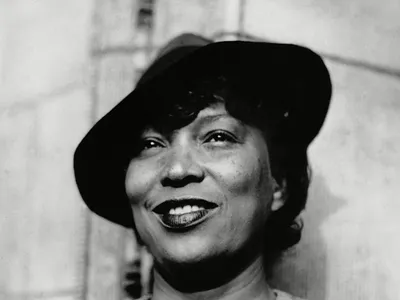Zora Hurston was a world-renowned writer and anthropologist. Hurston’s novels, short stories, and plays often depicted African American life in the South. Her work in anthropology examined black folklore. Hurston influenced many writers, forever cementing her place in history as one of the foremost female writers of the 20th century.
Zora Neale Hurston was born in Notasulga, Alabama on January 7, 1891. Both her parents had been enslaved. At a young age, her family relocated to Eatonville, Florida where they flourished. Eventually, her father became one of the town’s first mayors. In 1917, Hurston enrolled at Morgan College, where she completed her high school studies. She then attended Howard University and earned an associate’s degree. Hurston was an active student and participated in student government. She also co-founded the school’s renowned newspaper, The Hilltop. In 1925, Hurston received a scholarship to Barnard College and graduated three years later with a BA in anthropology. During her time as a student in New York City, Hurston befriended other writers such as Langston Hughes and Countee Cullen. Together, the group of writers joined the black cultural renaissance which was taking place in Harlem.
Throughout her life, Hurston, dedicated herself to promoting and studying black culture. She traveled to both Haiti and Jamaica to study the religions of the African diaspora. Her findings were also included in several newspapers throughout the United States. Hurston often incorporated her research into her fictional writing. As an author Hurston, started publishing short stories as early as 1920. Unfortunately, her work was ignored by the mainstream literary audience for years. However, she gained a following among African Americans. In 1935, she published Mules and Men. She later, collaborated with Langston Hughes to create the play, Mule Bone. She published three books between 1934 and 1939. One of her most popular works was Their Eyes were Watching God. The fictional story chronicled the tumultuous life of Janie Crawford. Hurston broke literary norms by focusing her work on the experience of a black woman.
Hurston was not only a writer, she also dedicated her life to educating others about the arts. In 1934, she established a school of dramatic arts at Bethune-Cookman College. Five years later she worked as a drama teacher at the North Carolina College for Negroes at Durham. Although Hurston eventually received praise for her works, she was often underpaid. Therefore, she remained in debt and poverty. After years of writing, Hurston had to enter the St. Lucie County Welfare Home as she was unable to take care of herself. Hurston died of heart disease on January 28, 1960. At first, her remains were placed in an unmarked grave. In 1972, author Alice Walker located her grave and created a marker. Although, Hurston’s work was not widely known during her life, in death she ranks among the best writers of the 20th century. Her work continues to influences writers throughout the world.
For a number of years Hurston was on the faculty of North Carolina College for Negroes (now North Carolina Central University) in Durham. She also was on the staff of the Library of Congress. Dust Tracks on a Road (1942), an autobiography, is highly regarded. Her last book, Seraph on the Suwanee, a novel, appeared in 1948.
Despite her early promise, by the time of her death in 1960 Hurston was little remembered by the general reading public, but there was a resurgence of interest in her work in the late 20th century. In addition to Mule Bone, several other collections of her work were published posthumously; these (1985), The Complete Stories (1995), and Every Tongue Got to Confess (2001), a collection of folktales from the South. In 1995 the Library of America published a two-volume set of Hurston’s work in its series. In addition, Hurston’s Barracoon: The Story of the Last “Black Cargo” was released in 2018. Although completed in 1931, this nonfiction work was originally rejected by publishers because of its use of vernacular. It tells the story of Cudjo Lewis, who was believed to be the last survivor of the final ship that brought enslaved Africans to the United States. Ibram X. Kendi adapted several folktales collected by Hurston as books for children in the 2020s.
In 1930 Hurston collaborated with Hughes on a play (never finished) titled Mule Bone: A Comedy of Negro Life in Three Acts (published posthumously 1991). In 1934 she published her first novel, Jonah’s Gourd Vine, which was well received by critics for its portrayal of African American life uncluttered by stock figures or sentimentality. Mules and Men, a study of folkways among the African American population of Florida, followed in 1935. Their Eyes Were Watching God (1937), a novel, Tell My Horse (1938), a blend of travel writing and anthropology based on her investigations of voodoo (Vodou) in Haiti, and Moses, Man of the Mountain (1939), a novel, firmly established her as a major author.
She attended Howard University from 1921 to 1924 and in 1925 won a scholarship to Barnard College, where she studied anthropology under Franz Boas. She graduated from Barnard in 1928 and for two years pursued graduate studies in anthropology at Columbia University. She also conducted field studies in folklore among African Americans in the South. Her trips were funded by folklorist Charlotte Mason, who was a patron to both Hurston and Langston Hughes. For a short time Hurston was an amanuensis to novelist Fannie Hurst.
Read More:
BBNaija ZinWe (chinwe and zion) biography





